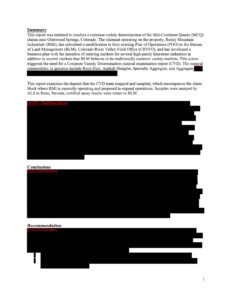Document shows most of mined limestone fails to qualify for Mining Law of 1872
On Jan. 31, 2024, the U.S. Bureau of Land Management sent out a website link for the public to access its long-awaited Determination of Common Variety report for the Rocky Mountain Industrials limestone mine. (Scroll down for link.)
The Determination report, or DCV, shows that the majority of limestone sales from RMI’s current quarry and for its proposed mine expansion fail to qualify under the Mining Law of 1872.
The Citizens’ Alliance has contended for years that RMI has been mining limestone for purposes far afield from its permit for mining on federal land, which is based on a narrow list of uses allowed under the Mining Law of 1872.
BLM Field Manager Larry Sandoval summarized the DCV’s findings last Thursday, saying, “BLM has determined that a majority of the material is not disposable under the Mining Law of 1872 because of being marketed for common purposes.”
For example, the DCV notes that RMI’s expansion proposal “provided no evidence or data that substantiates that this [limestone] deposit has unique or special properties that set it apart from other deposits that are used for aggregate for the same purposes.” (DCV page 47 / PDF page 56)
The agency’s position marks a pivotal point in its review of current mining at the Transfer Trail quarry and of RMI’s massive proposed mine expansion, said Jeff Peterson, president of the Citizens’ Alliance.
If RMI’s end uses for the mined limestone had qualified under the 1872 Mining Law, the company would have few regulatory limits on environmental and economic impacts, and would have no obligation to pay royalties on its sales.
Most end uses appear to require sales contract
The DCV disqualifies almost all end uses put forth by RMI, such as rock dust for coal mines, road base, rip-rap, structural boulders and chicken grit.
Mining and sales of these non-qualifying uses would need to be approved under a BLM mineral sales contract, which entails a process that would include public review.
The DCV singles out just one possible exception that would qualify under the 1872 Mining Law, the use of high-quality limestone in adjusting the chemical balance in cement for airport runways. BLM has provided no evidence in the redacted DCV to show that RMI has sold any limestone for that purpose. BLM has also refused the Alliance’s many requests to produce RMI’s recent sales records to verify these assertions.
Citizens’ Alliance calls for halt to mining
The DCV offers detailed background on the quarry’s history. The purpose for the quarry from its beginning, in 1982, was solely for rock dust, used to suppress methane eruptions in the underground coal mines near Redstone.
“With the DCV’s findings in hand, it appears that original mine approvals from 1982 are no longer valid,” said Peterson.
“Mining should be halted unless RMI obtains a federal mineral sales contract and resolves its other permit noncompliance problems,” he said.
Half of DCV remains blacked out
 About half of the contents of the DCV released to the public on Wednesday were blacked out, including narrative, tables, maps and photos.
About half of the contents of the DCV released to the public on Wednesday were blacked out, including narrative, tables, maps and photos.
Of the 205-page report, 75 pages were fully blacked out with redactions and another 23 pages were partially redacted. For example, the report’s Conclusion and Recommendations sections, shown at right, were fully blacked out.
“There’s enough of the report visible,” Peterson said, “to see that the limestone is being used for purposes that fail to meet BLM’s previous mining approvals, which were based on uses allowed under the Mining Law of 1872.”
BLM calls for release of funds in escrow
A cover letter to the DCV is addressed to Robert Wagner, an RMI vice president, calling on the company to tally the funds in an escrow account, established in 2019, by Feb. 20.
The letter, signed by BLM Field Manager Larry Sandoval, gives RMI until Feb. 25 to remit to BLM the escrowed payments for all sales that don’t qualify under the Mining Law.
Download the redacted Determination of Common Variety report here.
Caution: large file size: 205 pages, 29 MB
https://www.blm.gov/sites/default/files/docs/2024-01/DOI-BLM-CO-DCV.pdf